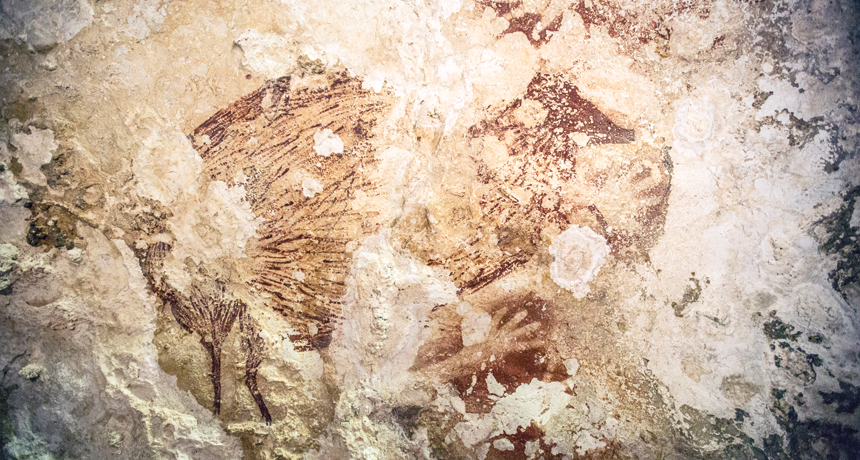Indonesian stencils rival age of Europe’s early cave art
Hand prints outlined in pigment were created nearly 40,000 years ago

OLD HAND Hand stencils such as this one previously found in caves on the Indonesian island of Sulawesi date to the Stone Age, a new study finds. Two hand prints are about as old as the earliest examples of European cave art.
Kinez Riza
So much for Europe’s reputation as the birthplace of cave art.
A couple of hand outlines framed in pigment, discovered decades ago inside caves on the Indonesian island of Sulawesi, were created roughly 40,000 years ago, a new study finds, making them similar in age to Europe’s oldest art. Two animal drawings inside Sulawesi caves are almost as old as the hand prints.
These Southeast Asian discoveries challenge a longstanding view that a burst of Stone Age creativity, exemplified by cave art, first occurred in Western Europe around 40,000 years ago before appearing in other parts of the world.
People living on Sulawesi, about 13,000 kilometers from famous cave paintings in France and Spain, made artistic strides comparable to those of West Europeans at the same Stone Age juncture, reports a team led by archaeologists Maxime Aubert and Adam Brumm, both of Griffith University in Southport, Australia. The oldest Sulawesi hand stencil, formed by blowing, spraying or spitting liquid pigment around an outstretched hand pressed against a cave wall, dates to at least 39,900 years ago, the researchers report in the Oct. 9 Nature.

A hand stencil in a nearby cave was made at least 39,400 years ago, they say. Minimum age estimates for other Sulawesi hand stencils ranged from around 35,000 to 17,000 years old.
A cave drawing of a fruit-eating pig called a babirusa, or pig-deer, dates to a minimum of 35,400 years ago. A portrayal of another large animal, probably a pig, dates to at least 35,700 years ago.
“Our findings show that cave art was made at opposite ends of the [Stone Age] world at about the same time, suggesting these practices have deeper origins, perhaps in Africa before our species spread across the globe,” Aubert says.
Aubert and Brumm’s team used a relatively new rock-dating technique called uranium-series dating to analyze mineral deposits that had formed over parts of 12 human hand stencils and two animal drawings from nine caves on Sulawesi. Radioactive decay of uranium in mineral deposits proceeds at a known rate, enabling scientists to date the formations and obtain a minimum age estimate for cave art underneath.
A previous uranium-series investigation found that a red disk on the wall of a Spanish cave dated to at least 40,800 years ago, making it the oldest known example of cave art (SN: 7/28/12, p. 15). A hand stencil in the same cave was made by 37,300 years ago.
Cave art apparently took similar paths in Europe and Southeast Asia, with hand stencils appearing first and animal drawings soon after, says archaeologist Paul Pettitt of Durham University in England. Hands hold great significance across cultures as bodily tools for acting on the world. Blowing pigment at hands placed on cave walls may have been especially meaningful and a spur to the development of human art, Pettitt suggests.
“It wouldn’t take much to observe that if the hand could be depicted in outline, so could other things, like animals,” he says. “The Sulawesi discoveries suggest that widely dispersed human groups shared in this immense discovery.”
A big challenge now is to track artistic traditions from their African origins to the beginnings of European and Asian cave art, Pettitt adds. By 100,000 years ago, Homo sapiens had concocted a red-hued paint and carved geometric designs in chunks of pigment at a cave on what’s now South Africa’s coast (SN: 11/19/11, p. 16).
No single method of dating rock art, whether uranium-series analyses of mineral formations or — as has been previously attempted — radiocarbon analyses of bits of paint, is definitive, cautions Robert Bednarik, an independent scholar and self-taught authority on rock art based in Caulfield South, Australia. Results from both techniques need to be checked for consistency, he says.
Editor’s Note: This article was updated October 28, 2014, to correct the number of caves in Sulawesi from which the researchers studied art.






